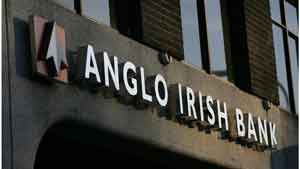COLLECTING THE 21ST CENTURY— THE ANGLO IRISH BANK SIGN
Published in Artefacts, Issue 2 (March/April 2023), Volume 31By Lar Joye

The sign on Anglo Irish Bank’s former headquarters at St Stephen’s Green, Dublin—now on display in the National Museum of Ireland (Decorative Arts and History), Collins Barracks. (Bryan O’Brien/Irish Times)
Museums are often seen as exhibiting items from another age and as having nothing to tell us about the contemporary world. Museums, however, are now collecting more from the present to open discussion about the world in which we live today. Recently the National Museum of Ireland has hosted the ‘Rainbow Revolution’ exhibition—a series of artefacts that define some of the most memorable moments in the LGBTI+ movement in recent years—and also has on display the Anglo Irish Bank sign, which was the 99th object in Fintan O’Toole’s A history of Ireland in 100 objects (Royal Irish Academy, 2013). The sign was on the front of the bank’s headquarters in Dublin’s St Stephen’s Green from 2000 to 2011 and has become a symbol of the excesses of the Celtic Tiger era (c. 1995–2008).
Allied Irish Banks (AIB) used a Noah’s Ark logo derived from a Celtic cross at Killary church, Co. Meath, and in a similar vein Anglo Irish Bank chose a distinctive Irish arrow or spearhead symbol based on ‘early Irish references such as flint arrowheads, typography from the Book of Kells and grafted gold artefacts’. This new brand highlighted a dramatic change for a bank that had been founded in 1964 and grew from a loan book of £92 million in 1987 to lending €18 billion in 2007. The bank was central to the property bubble, which finally burst in 2008, forcing the Irish government to nationalise it and costing the Irish taxpayer over €30 billion.
While this crash is often portrayed as a terrible one-off event, deeply regretted by those bankers involved, the Irish Central Bank, senior civil servants and politicians, it followed a pattern that began when Ireland joined the EEC in 1973. In Something rotten: Irish banking scandals (Gill & Macmillan), published two years before the crash, Simon Carswell described scandals at the Irish Trust Bank, Merchant Banking, PMPA, the Insurance Corporation of Ireland, Ansbacher, National Irish Bank, the DIRT scandal and John Rusnak, AIB’s rogue trader. Indeed, AIB featured in many of these scandals and was also involved in writing off the debts of VIP customers, including Charles J. Haughey, in the 1980s. Have we learnt anything from those 35 years of banking scandals? (We have not had a major bank crash since 2008.) The banking market is getting smaller, however, as international banks leave, perhaps creating the perfect situation for a new crisis.
Lar Joye is Heritage Officer of Dublin Port.
















